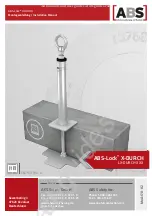
46
Cooling Grain for Winter Storage
Crops should be kept near average outdoor temperatures during fall using airflow. Increasing airflow rate reduces
time needed for cooling or warming, but also increases power requirements. Begin
aeration to reduce grain
temperature when average outdoor temperature is about 10°F to 15° F (6°C to 8° C) lower than grain
temperature. The average outdoor temperature is the average daily high/low. You can estimate when a cooling or
warming cycle has passed through the crop by measuring its temperature.
Repeat this cycle as often as
necessary, checking temperature at several locations until grain has cooled to 35°F to 45°F (2°C to 7°C).
For pressure systems, check temperature at top of grain. For suction, check temperature coming out of fan.
Check grain and air temperature to
ensure cooling fronts have moved completely through the grain
and
aeration cycle is complete.
Allowing a moisture front to remain within grain mass will cause spoilage.
Table 20
shows length of time required to change grain temperature.
Table 20
- Approximate Grain Cooling or Warming Times
Airflow Rate
Fan Hours by Season
CFM/Bu m³/hr/MT
Fall
Winter
Spring
1/20
4
300
400
240
1/10
8
150
200
120
1/5
15
75
100
60
14
19
60
80
48
1/3
25
45
61
36
1/2
38
30
40
24
3/4
57
20
27
16
1
76
15
20
12
1-1/4
95
12
16
10
1-1/2
114
10
13
8
DO NOT FREEZE GRAIN
due to problems it can create, particularly during warming and in larger bins.
Condensation during aeration can be a problem in grain cooled below freezing. It will be difficult to warm grain in
spring without condensation immediately freezing into ice. Frozen chunks block aeration warming cycles and
grain unloading.
Condensation also re-wets grain and can cause sudden bin failure and collapse due to
expansion of kernels.
If grain does freeze, begin thawing it once the average outdoor temperature is 10° to 15°
degrees F (6° to 8°C) above grain temperature. Follow steps outlined in segment below.
Failure to follow
instructions for thawing frozen grain may result in sudden bin collapse and failure.
Managing Grain in Spring and Summer
Start fan when average outdoor temperature is 10° to 15° F (6° to 8° C) above grain temperature. Once warm-up
cycle is started, do not turn fan off. Stopping the warming front before a cycle is completed encourages
condensation of moisture and spoilage. As outside temperatures continue to rise, repeat this cycle as often as
needed until average grain temperature is 50° to 60° F (10° to 16° C).
Maintain grain temp. within 10° - 15° F
(5° to 8° C) of the average monthly temp.
Do not warm grain to summer temperatures above 60
F (16
C) in
the southern U.S. or 50
F (10
C)
in the northern U.S. due to insect infestation and other storage issues.
IV.
Addressing Grain Storage Problems
Stirring machines provide an ideal solution to many common grain storage problems. The table below details
some of the problems of grain management that can arise and the action you should take.
Table 21
- Common Grain Storage Problems and Recommended Action
Observation
Probable Cause
Recommended Action
Musty or spoiled grain odor.
Hard layer or core grain below.
Surface grain wet or slimy.
Grain is sticking or frozen
together.
Hard surface crust, caked, and
blocking airflow.
Heating moisture accumulation or
moisture migration occurring.
Run fan without heater and turn on
stirring machine.
Summary of Contents for Fastir
Page 4: ...Limited Warranty 4 LIMITED WARRANTY...
Page 50: ...Appendix A Wiring Diagrams 50 Figure 52 Double Auger Fastir Wiring Diagram...
Page 51: ...Appendix A Wiring Diagrams 51 Figure 53 Triple Auger Fastir Wiring Diagram...
Page 52: ...Appendix A Wiring Diagrams 52 Figure 54 Quadruple Auger Fastir Wiring Diagram...
















































